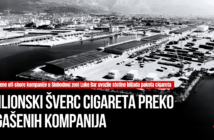 Citizens of Montenegro lost around one million only in the last three years, due to the Energy Regulatory Agency’s methodology of calculation of transmission and distribution losses which were to the advantage of Montenegrin Electric Enterprise (EPCG). When it comes to calculation of EPCG distribution losses, the Energy Regulatory Agency (RAE) determined the percentage of losses in the period from 2012 to 2015 on a flat-rate basis.
Citizens of Montenegro lost around one million only in the last three years, due to the Energy Regulatory Agency’s methodology of calculation of transmission and distribution losses which were to the advantage of Montenegrin Electric Enterprise (EPCG). When it comes to calculation of EPCG distribution losses, the Energy Regulatory Agency (RAE) determined the percentage of losses in the period from 2012 to 2015 on a flat-rate basis.
Namely, the calculation was supposed to be based on a study on electricity distribution losses that EPCG should have submitted to RAE. EPCG had been obliged to deliver the study by April 2012, revised by an independent qualified body in Montenegro. However, EPCG ignored this obligation, so RAE determined a distribution loss of 9 percent on a flat-rate basis, thus allowing the electricity company to earn a revenue of €24.7 million in a three-year regulatory period. The income earned this way is up to 10.9 percent of the total allowed revenue of EPCG for these three years, which is a significant percentage if having in mind that distribution loss is in question.
Transmission and distribution losses in Montenegro amounted to 8.6 percent, which is less than the losses RAE determined on a flat-rate basis. The difference between the level of losses allowed by RAE to EPCG and those that were actually made is the amount the citizens were to pay as buyers of electricity from EPCG.
The study on the basis of which the percentage of real loss was to be determined was not published until 2015, and for the needs of EPCG it was done by a team of professors from the Faculty of Electrical Engineering in Podgorica, led by Professor Ilija Vujosevic. The main conclusion of the study is that the technical losses in Montenegro are 8.6 percent. Out of these five coastal municipalities have losses below the EU average, whereas 7.3 percent was taken as the average rate. Thus, the losses in Tivat are 5.6 percent, 6.6 percent in Budva, in Bar 6.7 per cent, 6.8 per cent in Kotor and in Herceg Novi 7.2 percent.
Two other municipalities are below the EU average: Mojkovac 7 percent and Podgorica 7.1 percent. Next are Ulcinj with 9.6 per cent, Rozaje 10 per cent, Berane 11 percent, Pljevlja 11.1 percent, Bijelo Polje 11.7 percent and Kolasin 12.6 percent. The municipalities with the biggest recorded technical losses are Cetinje with 13.1 percent, Niksic 13.7 percent and Zabljak 14.9 percent.
The authors of the study state that the EPCG submitted a comprehensive database of network and energy data for 2010 and 2011 as the groundwork for the documentation, but the analyses have shown that there are errors and discrepancies when compared to the power network data for urban and rural areas. Therefore, in 2014, calculations of losses in three representative municipalities – Budva (urban area), Zabljak (rural area) and Podgorica (urban and rural areas) – were made for the entire power distribution system with the additional data.
The study indicates that the technical losses are determined by technical condition and maintenance of the system, while so-called commercial losses arising from the imprecision of measurements, unsynchronized readings, and increased consumption during the disturbed operational regimes and electricity theft considerably contribute to the entire losses.
That making a study on reducing losses was not in the interest of EPCG is shown by the fact that it was only in October 2012 that it concluded a contract with a team of professors from the Faculty of Electrical Engineering, and that, due to the incomplete data, the study was being developed almost three years and delivered to the RAE in June this year.
A2A’s entering into the state energy company as a strategic partner has been justified by the needs of modernizing the power distribution network, but citizens still pay, through their electricity bills, a significant amount for the losses, while money that can be invested in the infrastructure is still kept in private banks.
In July MANS filed a complaint against the head of RAE for determining flat tariffs for the losses to the detriment of consumers, and to the advantage of EPCG, whereas a new complaint on these grounds will be filed against the leadership of EPCG early next week.
Author: MANS Investigation Centre
This text is created with the support of the European Union within the project “Zero Tolerance to Corruption”. Network for Affirmation of Non-Governmental Sector – MANS is solely responsible for the contents of this article, and the views taken herein shall not in any case be considered as those of the European Union.



